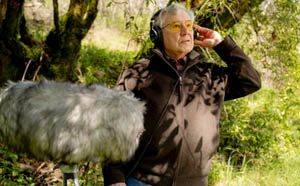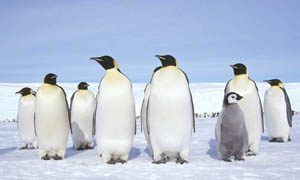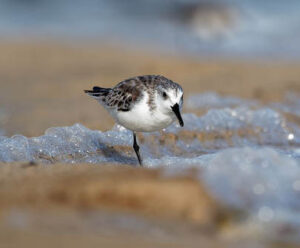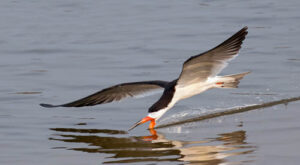Birds, Climate, Ecology
![]()
Rachel Carson loved all life, valued all life, and taught us about its miraculous evolution. She evoked its wonder and its interconnectedness. Her empathy extended even to the smallest creatures. In her field notes, she worried about the well-being of a tiny, one-legged sanderling she saw hopping in the surf. How had it, how would it, survive? From her earliest published writing, she warned about the decline of fish and birds and habitat in the face of pollution, development, even the warming of the oceans that she would learn before her death was the result of human-induced global climate change. Her writing and her advocacy about the coast and oceans, factory farms, woodlands, pollution, and climate culminated in Silent Spring. It elevated ecology into the mainstream of American life. Ever since, we understand that human beings, our health and well-being, are inseparable from our surroundings, from other species. What harms one, harms all.
 Carson and we are often led to these perceptions by following birds, by watching and wondering about how and whether they will survive, as well as offer song and beauty. To see birds, we learn that they have evolved and are marvelously adapted to particular places, or ecosystems. We find the endangered Red-cockaded woodpeckers where there are southern longleaf pines, American avocets along marshes and mudflats, whimbrels walking on the beach, American oystercatchers near rocks and beds of oysters, wild turkeys in forests where there are acorns and other nuts, and robins wherever earthworms can be found.
Carson and we are often led to these perceptions by following birds, by watching and wondering about how and whether they will survive, as well as offer song and beauty. To see birds, we learn that they have evolved and are marvelously adapted to particular places, or ecosystems. We find the endangered Red-cockaded woodpeckers where there are southern longleaf pines, American avocets along marshes and mudflats, whimbrels walking on the beach, American oystercatchers near rocks and beds of oysters, wild turkeys in forests where there are acorns and other nuts, and robins wherever earthworms can be found.
If forests increase, so do turkeys, as they have in the Eastern U.S. If longleaf pines are clear cut, red-cockaded woodpeckers begin to disappear. If sea-level rise inundates beaches, marshes, or small islands, our sea and shore birds are affected. The Black Skimmer, the marvelous bird known as Rynchops that opens Rachel Carson’s Under the Sea-Wind and breeds on small offshore islands is the most likely to be destroyed. And global climate change alters the ecology and ecosystems of everything. Recent studies have shown some 400 North American bird species at risk from climate change.
Since the Rachel Carson Council was founded, our American bird populations have plummeted by some 70%, or about 2.9 billion breeding adults. Migrating birds return from their lengthy journeys emaciated for lack of places to stop or sufficient food where it once was found.
What affects the birds, of course, affects us. We depend on a steady temperate climate, on clean air and water, on safe places to dwell, on food from the land as much as any bird. It is why the Endangered Species Act protects entire ecosystems, not just the species that is in danger. It is why, as we report on birds, as we watch and wonder, you will find here more than just the state of bird life. Ending chemical pollution, stopping climate change, preserving ecosystems, tracking inequities — which of us gets hurt most when the lives of birds and everything around us is disrupted or destroyed — is how the Rachel Carson Council protects and preserves the birds. And ourselves.
No Birdsong, No Water in the Creek, No Beating Wings: How a Haven For Nature Fell Silent The tale starts 30 years ago, when Bernie Krause made his first audio clip in Sugarloaf Ridge state park, 20 minutes’ drive from his house near San Francisco. He chose a spot near an old bigleaf maple. Many people loved this place: there was a creek and a scattering of picnic benches nearby. Read more ‘Simply Mind-boggling’: World Record Temperature Jump in Antarctic Raises Fears of Catastrophe On 18 March, 2022, scientists at the Concordia research station on the east Antarctic plateau documented a remarkable event. They recorded the largest jump in temperature ever measured at a meteorological centre on Earth. According to their instruments, the region that day experienced a rise of 38.5C above its seasonal average: a world record. Read more Past Issues of the Past Birds, Climate andThe Latest on Birds Climate and Ecology
 As the soundscape of the natural world began to disappear over 30 years, one man was listening and recording it all
As the soundscape of the natural world began to disappear over 30 years, one man was listening and recording it all
 An unprecedented leap of 38.5C in the coldest place on Earth is a harbinger of a disaster for humans and the local ecosystem.
An unprecedented leap of 38.5C in the coldest place on Earth is a harbinger of a disaster for humans and the local ecosystem.
![]() Sign Up Here to Receive the Monthly RCC Bird Watch and Wonder and Other RCC Newsletters, Information and Alerts.
Sign Up Here to Receive the Monthly RCC Bird Watch and Wonder and Other RCC Newsletters, Information and Alerts.
RCC Bird Watch and Wonder
Ecology Archive








